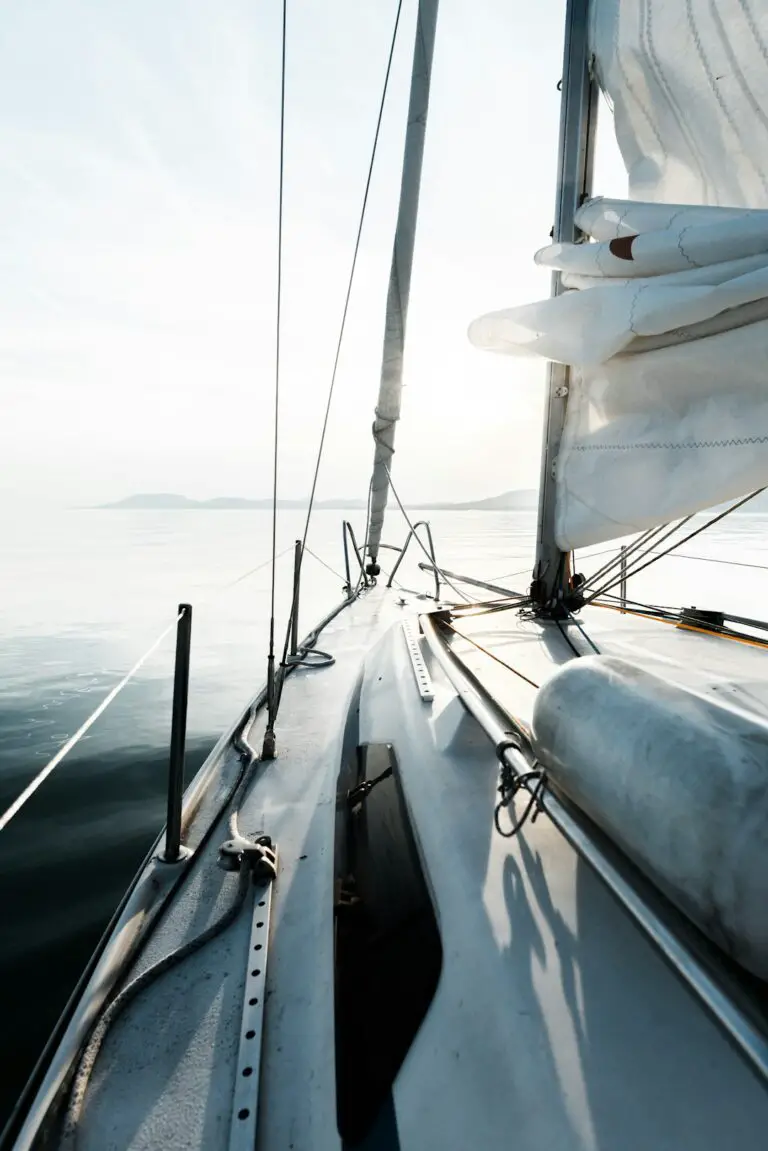Support our hydrofoil educational content for free when you purchase through links on our site. Learn more
Why Did the U.S. Navy Abandon Hydrofoils? 🤔
Have you ever wondered why a technology that seemed so promising was left behind? The U.S. Navy’s venture into hydrofoils was a thrilling chapter in maritime innovation, showcasing vessels that could literally fly above the waves. Yet, despite their impressive speed and agility, these futuristic ships were ultimately retired. In this article, we dive deep into the reasons behind the Navy’s decision to abandon hydrofoils, exploring the challenges they faced and the lessons learned.
Did you know that the USS Tucumcari, one of the Navy’s first hydrofoils, could reach speeds of over 50 knots? As we unravel the story of hydrofoils, we’ll also look at their legacy and potential future applications. Stick around, because you might be surprised by what’s next for hydrofoil technology!
Key Takeaways
- Hydrofoils showcased incredible speed and stability, making them ideal for rapid naval operations.
- High acquisition and maintenance costs led to their decline in favor of more conventional vessels.
- Shifting military priorities and advancements in traditional ship design influenced the Navy’s decision to abandon hydrofoils.
- Despite their challenges, hydrofoils still hold promise for niche applications in military and civilian sectors.
- Innovations in materials and propulsion may pave the way for a resurgence of hydrofoil technology in the future.
If you’re intrigued by hydrofoils and want to explore the latest in hydrofoil boards or equipment, check out our recommendations on Amazon! 🌊
Table of Contents
- Quick Tips and Facts
- The Rise and Fall of Hydrofoils in the U.S. Navy
- Understanding Hydrofoil Technology: What Makes It Unique?
- Key Advantages of Hydrofoils for Naval Operations
- Challenges Faced by the U.S. Navy with Hydrofoils
- The Decision to Abandon Hydrofoils: Insights and Implications
- Comparative Analysis: Hydrofoils vs. Conventional Naval Vessels
- The Future of Hydrofoils in Military and Civilian Applications
- Innovations in Hydrofoil Technology: What’s Next?
- Conclusion
- Recommended Links
- FAQ
- Reference Links
Quick Tips and Facts
- Hydrofoils are not new: The technology has been around for over a century, with early experiments dating back to the late 1800s. 🤯
- Speed demons: Hydrofoils are known for their impressive speed capabilities, often exceeding those of conventional vessels. Discover the 10 Largest Hydrofoil Boats That Redefine Speed and Innovation! 🚤 at https://www.hydrofoiling.org/largest-hydrofoil-boat/ .
- Smooth ride: By lifting the hull out of the water, hydrofoils offer a remarkably stable and comfortable ride, even in rough seas. 😌
- Military and civilian applications: While primarily associated with military use, hydrofoils have also found applications in passenger ferries, racing boats, and even recreational water sports. 🏄♂️
- The future of hydrofoils: Ongoing research and development efforts continue to push the boundaries of hydrofoil technology, exploring new materials, designs, and propulsion systems.
The Rise and Fall of Hydrofoils in the U.S. Navy ⚓
The U.S. Navy’s fascination with hydrofoils began in the mid-20th century, driven by the promise of high-speed, agile vessels that could outmaneuver enemy threats. This led to the development and deployment of several notable hydrofoil classes, each with its own unique characteristics and purpose.
The Early Years: Experimentation and Promise
The Navy’s early forays into hydrofoil technology were marked by experimentation and a desire to explore the potential of these unconventional vessels. The USS Tucumcari (PGH-2), commissioned in 1968, exemplified this spirit. A small, fast patrol boat, the Tucumcari showcased the speed and maneuverability advantages of hydrofoils, reaching speeds of over 50 knots (57 mph) while foilborne. It saw action in the Vietnam War, demonstrating the potential of hydrofoils for coastal patrol and combat operations.
The Pegasus Class: A Bold Vision Cut Short
The Pegasus class represented the pinnacle of the U.S. Navy’s investment in hydrofoil technology. These missile-armed patrol boats, designed for high-speed operations in the North Atlantic, were envisioned as a key component of NATO’s Cold War naval strategy. However, despite their impressive capabilities—a top speed of 48 knots (55 mph) and a formidable armament of eight Harpoon anti-ship missiles—the Pegasus class faced an unfortunate fate.
As noted in a historical account on Wikipedia, “The ships were retired because they were not judged cost-effective for their mission in a Navy with primarily offensive missions rather than coastal patrol.” Escalating costs, coupled with changing strategic priorities, led to the class’s premature retirement in the early 1990s.
The Legacy of U.S. Navy Hydrofoils
Despite their relatively short service life, the U.S. Navy’s hydrofoil programs left a lasting impact on naval architecture and maritime technology. The lessons learned from these vessels, both in terms of their advantages and limitations, continue to inform the development of advanced naval platforms today.
Learn more about Hydrofoil History: Hydrofoil History
Understanding Hydrofoil Technology: What Makes It Unique? 🤔
Imagine a boat that could literally fly above the water, gliding effortlessly over the waves. That’s the essence of hydrofoil technology! But how do these seemingly magical vessels actually work?
The Science Behind the Glide
Hydrofoils operate on the principle of hydrodynamic lift. As a hydrofoil-equipped vessel gains speed, its submerged foils generate lift, much like the wings of an airplane. This lift force gradually raises the hull out of the water, significantly reducing drag and allowing the vessel to achieve remarkable speeds.
Key Components of a Hydrofoil System
- Foils: These wing-like structures, typically located beneath the hull, are the heart of a hydrofoil system. Their shape and angle of attack are crucial for generating lift.
- Struts: Connecting the foils to the hull, struts provide structural support and often house control mechanisms.
- Control System: A sophisticated control system constantly adjusts the angle of the foils, ensuring optimal lift and stability across varying speeds and sea conditions.
Types of Hydrofoil Systems
- Surface-piercing: As the name suggests, these systems feature foils that pierce the water’s surface. They are simpler in design but can be less stable in rough seas.
- Fully submerged: These systems have foils that remain fully submerged, offering greater stability and a smoother ride. However, they require more complex control systems.
Explore Hydrofoil Basics: Hydrofoil Basics
Key Advantages of Hydrofoils for Naval Operations 🚀
Hydrofoils offer a compelling blend of speed, agility, and efficiency, making them attractive for various naval applications. Let’s delve into the key advantages that make them stand out:
1. Unmatched Speed and Maneuverability
Hydrofoils are renowned for their ability to achieve significantly higher speeds than conventional vessels of comparable size. By minimizing drag, they can zip across the water with remarkable swiftness, making them ideal for rapid response missions, interdiction operations, and outmaneuvering enemy threats.
2. Enhanced Stability and Seakeeping
Contrary to what one might expect, hydrofoils offer exceptional stability, even in rough seas. Once foilborne, the vessel is less affected by wave action, providing a smoother and more comfortable ride for the crew. This stability is particularly advantageous for missions requiring precision and accuracy, such as weapons deployment or surveillance operations.
3. Reduced Wake and Acoustic Signature
The elevated profile of a hydrofoil results in a smaller wake compared to displacement hulls. This reduced wake translates into a lower radar signature, making them stealthier and more difficult to detect. Moreover, the reduced contact with water also minimizes noise generation, enhancing their acoustic stealth capabilities.
4. Fuel Efficiency at High Speeds
While hydrofoils may consume more fuel at low speeds due to the energy required to lift the hull, they become remarkably fuel-efficient once foilborne. At high speeds, the reduced drag allows them to cover greater distances with less fuel compared to conventional vessels.
Dive into Advanced Hydrofoiling Techniques: Advanced Hydrofoiling Techniques
Challenges Faced by the U.S. Navy with Hydrofoils 🚧
Despite their allure, hydrofoils present unique challenges that contributed to the U.S. Navy’s decision to scale back their use. Understanding these challenges provides valuable insights into the complexities of naval technology and operational requirements.
1. High Acquisition and Maintenance Costs
Hydrofoils are inherently more complex and expensive to build and maintain than traditional vessels. Their specialized components, intricate control systems, and the need for lightweight yet durable materials all contribute to higher acquisition costs. Furthermore, the maintenance of hydrofoil systems, particularly the foils and their actuation mechanisms, can be demanding and costly.
2. Vulnerability to Damage and Fouling
The exposed nature of hydrofoils, particularly in surface-piercing designs, makes them susceptible to damage from debris, shallow water obstacles, and even marine life. Collisions with submerged objects can cause significant damage to the foils, potentially rendering the vessel inoperable. Additionally, marine growth and fouling can accumulate on the foils, affecting their hydrodynamic performance and requiring regular cleaning.
3. Operational Limitations in Shallow Water
Hydrofoils, especially those with fixed foils, face limitations in shallow water environments. Their draft, even when foilborne, can restrict their access to certain coastal areas, rivers, and harbors. This limitation can hinder their effectiveness in littoral operations, which often require maneuverability in confined spaces.
4. Complexity and Specialized Training
Operating and maintaining hydrofoils demand a higher level of technical expertise compared to conventional vessels. Crews require specialized training on hydrofoil systems, control mechanisms, and emergency procedures. This training overhead can add to the overall cost and logistical challenges of operating hydrofoils.
The Decision to Abandon Hydrofoils: Insights and Implications 🤔
The U.S. Navy’s decision to move away from hydrofoils in the late 20th century was driven by a confluence of factors, including budgetary constraints, evolving strategic priorities, and the inherent limitations of the technology at the time.
1. Shifting Strategic Landscape
The end of the Cold War brought a significant shift in the U.S. Navy’s strategic outlook. The perceived threat of large-scale naval confrontations diminished, while the focus shifted towards littoral operations, power projection, and expeditionary warfare. This shift in priorities led to a reassessment of the Navy’s force structure and the types of vessels best suited for these evolving missions.
2. Budgetary Pressures and Cost-Effectiveness
The high acquisition and maintenance costs associated with hydrofoils became increasingly difficult to justify in a post-Cold War environment of shrinking defense budgets. The Navy faced pressure to prioritize programs that offered the greatest capability and flexibility within constrained resources. In this context, the specialized nature and limited operational flexibility of hydrofoils made them vulnerable to budget cuts.
3. Technological Advancements in Conventional Vessels
While the U.S. Navy was exploring hydrofoil technology, significant advancements were also being made in conventional ship design and propulsion systems. New hull forms, advanced materials, and more powerful engines enabled traditional vessels to achieve higher speeds and greater fuel efficiency, narrowing the performance gap with hydrofoils.
4. The Enduring Allure of Hydrofoils
Despite the U.S. Navy’s decision to move away from large-scale hydrofoil programs, the technology continues to hold promise for specific niche applications. Their speed, maneuverability, and stability remain attractive attributes for certain missions, particularly in coastal environments and for specialized roles.
Comparative Analysis: Hydrofoils vs. Conventional Naval Vessels 📊
To fully grasp the trade-offs and considerations surrounding hydrofoils, it’s helpful to compare their strengths and weaknesses against those of conventional naval vessels.
| Feature | Hydrofoils | Conventional Vessels |
|---|---|---|
| Speed | ✅ Significantly faster at high speeds | ❌ Slower, especially at high speeds |
| Stability | ✅ Exceptionally stable when foilborne | ❌ Can be less stable in rough seas |
| Stealth | ✅ Reduced wake and acoustic signature | ❌ Larger wake and higher detectability |
| Cost | ❌ High acquisition and maintenance costs | ✅ Generally more cost-effective |
| Versatility | ❌ Limited operational flexibility in shallow water | ✅ Greater versatility across various environments |
| Maintenance | ❌ Complex systems requiring specialized expertise | ✅ Relatively simpler maintenance procedures |
The Future of Hydrofoils in Military and Civilian Applications 🔮
While large-scale naval deployments of hydrofoils may be on hold, the technology continues to evolve and find new life in both military and civilian sectors.
1. Special Operations and Littoral Warfare
Hydrofoils’ speed, stealth, and shallow-water capabilities make them well-suited for specialized military operations, such as:
- Inserting and extracting special forces teams: Their ability to operate close to shore and quickly move in and out of hostile environments makes them ideal for clandestine missions.
- Conducting surveillance and reconnaissance: Their low profile and reduced wake enhance their stealth, allowing them to gather intelligence discreetly.
- Patrolling coastal waters and interdicting smuggling: Their speed and maneuverability enable them to intercept fast-moving targets in littoral zones.
2. High-Speed Passenger Ferries
Hydrofoils have a long and successful history as passenger ferries, particularly in areas with archipelagos or where speed is crucial for connecting islands and coastal communities. Their ability to transport passengers quickly and comfortably over water makes them an attractive alternative to traditional ferries or air travel.
3. Recreational Boating and Water Sports
The thrill of “flying” above the water has made hydrofoils increasingly popular in recreational boating and water sports. Hydrofoil-equipped sailboats, powerboats, and even personal watercraft offer exhilarating experiences and push the boundaries of speed and agility.
4. Research and Development: Pushing the Boundaries
Ongoing research and development efforts continue to explore new frontiers in hydrofoil technology. Innovations in materials, control systems, and propulsion systems aim to address the traditional limitations of hydrofoils, potentially paving the way for wider adoption in the future.
Find the perfect Hydrofoil Board: Hydrofoil Board Selection
Innovations in Hydrofoil Technology: What’s Next? ✨
The world of hydrofoils is far from static. Driven by technological advancements and a desire to overcome existing limitations, innovators are constantly pushing the boundaries of what these vessels can achieve.
1. Advanced Materials: Lighter, Stronger, More Durable
The quest for lightweight yet incredibly strong materials is paramount in hydrofoil design. New composite materials, such as carbon fiber reinforced polymers, offer exceptional strength-to-weight ratios, allowing for the construction of lighter and more efficient foils. These materials also exhibit excellent resistance to corrosion and fatigue, enhancing durability and reducing maintenance requirements.
2. Intelligent Control Systems: Enhancing Stability and Performance
Sophisticated control systems lie at the heart of modern hydrofoils, constantly monitoring and adjusting the angle of the foils to maintain optimal lift and stability. Advances in sensor technology, computing power, and control algorithms are leading to more responsive and adaptive systems. These intelligent systems can anticipate changes in sea conditions, adjust foil settings accordingly, and even compensate for shifts in weight distribution, ensuring a smoother and more stable ride.
3. Electric and Hybrid Propulsion: Towards a Greener Future
As the maritime industry seeks to reduce its environmental footprint, electric and hybrid propulsion systems are gaining traction in hydrofoil design. Electric motors offer quiet and emission-free operation, making them ideal for passenger ferries and recreational vessels operating in environmentally sensitive areas. Hybrid systems, combining electric motors with conventional engines, offer extended range and reduced fuel consumption.
4. The Rise of Autonomous Hydrofoils: A Glimpse into the Future
The rapid advancements in autonomous navigation technology are also making their mark on the world of hydrofoils. Autonomous hydrofoil vessels, capable of operating without human intervention, hold immense potential for a wide range of applications, including:
- Oceanographic research and data collection: Autonomous hydrofoils can be deployed for extended periods to gather valuable data on ocean currents, marine life, and environmental conditions.
- Surveillance and security patrols: Unmanned hydrofoils can patrol coastlines, monitor maritime traffic, and detect potential threats, enhancing security and surveillance capabilities.
- Logistics and transportation: Autonomous hydrofoils could revolutionize cargo transport, particularly in archipelagic regions, by providing a fast and efficient means of moving goods between islands and coastal hubs.
Read Hydrofoil Equipment Reviews: Hydrofoil Equipment Reviews
Conclusion 🎉

In summary, the U.S. Navy’s journey with hydrofoils has been a fascinating tale of innovation, promise, and ultimately, strategic reassessment. These vessels showcased incredible speed, stability, and stealth, making them a tantalizing option for naval operations. However, challenges such as high costs, maintenance complexities, and evolving military priorities led to their decline in favor of more conventional vessels.
Positives of Hydrofoils:
- Speed and Maneuverability: Hydrofoils can achieve remarkable speeds, making them ideal for rapid response missions.
- Stability: Once foilborne, they offer a smooth ride even in rough seas.
- Stealth: Reduced wake and acoustic signatures enhance their stealth capabilities.
Negatives of Hydrofoils:
- High Costs: Both acquisition and maintenance costs are significantly higher than conventional vessels.
- Operational Limitations: They struggle in shallow waters and require specialized training for crews.
- Complex Systems: The technology demands intricate control systems that can complicate operations.
Despite their challenges, hydrofoils continue to hold potential for niche applications in military and civilian sectors. As we look to the future, ongoing innovations in materials, propulsion, and autonomous systems may breathe new life into hydrofoil technology. If you’re intrigued by the possibilities of hydrofoils, keep an eye on developments in this exciting field!
Recommended Links 🛒
- Hydrofoil Boards: Shop Hydrofoil Boards on Amazon
- Hydrofoil Equipment Reviews: Explore Hydrofoil Equipment Reviews
- Books on Hydrofoils: Find Hydrofoil Books on Amazon
FAQ ❓

What are the advantages and disadvantages of hydrofoil technology in naval applications?
Advantages:
- Speed: Hydrofoils can reach speeds of over 50 knots, making them faster than conventional vessels.
- Stability: They provide a smoother ride by lifting the hull above the waves.
- Stealth: Their reduced wake and noise levels make them harder to detect.
Disadvantages:
- Cost: High initial and maintenance costs can deter investment.
- Operational Limitations: They are less effective in shallow waters and require specialized training.
- Complexity: The technology involves intricate systems that can complicate operations.
How did the US Navy’s experience with hydrofoils influence the development of modern naval vessels?
The Navy’s experience with hydrofoils highlighted the importance of balancing speed, cost, and operational flexibility. While hydrofoils demonstrated impressive capabilities, the lessons learned led to a focus on developing conventional vessels that could offer similar speed and efficiency without the associated complexities and costs. This influence is evident in the design of modern naval ships that prioritize versatility and cost-effectiveness.
What role did maintenance and operational costs play in the US Navy’s decision to abandon hydrofoils?
Maintenance and operational costs were significant factors in the Navy’s decision to abandon hydrofoils. The complexity of hydrofoil systems required specialized training and maintenance, which added to the overall cost. As budgets tightened and priorities shifted, the Navy opted to invest in more cost-effective conventional vessels that could fulfill a broader range of missions without the high overhead associated with hydrofoils.
Are there any modern military or commercial applications where hydrofoils are still being used or developed?
Yes, hydrofoils are still being explored for various military and commercial applications. In the military realm, they are being considered for special operations and surveillance missions due to their speed and stealth. In the commercial sector, hydrofoil ferries are popular in regions with high passenger traffic, providing fast and efficient transportation. Additionally, ongoing research into autonomous hydrofoil vessels is paving the way for innovative applications in logistics and environmental monitoring.
What are the environmental impacts of hydrofoil technology compared to traditional vessels?
Hydrofoils generally have a lower environmental impact at high speeds due to reduced fuel consumption and emissions. However, their construction and maintenance can involve environmentally harmful materials and processes. As the industry moves towards electric and hybrid propulsion systems, the environmental footprint of hydrofoils is expected to decrease further, making them a more sustainable option in the maritime sector.
Reference Links 📚
- Wikipedia – Pegasus-class hydrofoil
- Washington Our Home – USS Plainview
- The U.S. Navy Has Unveiled A New Hydrofoil, Its First In Decades
- Naval Technology – Hydrofoils
- Hydrofoil Basics
With the U.S. Navy’s renewed interest in hydrofoils and ongoing advancements in technology, we may very well see a resurgence of these fascinating vessels in the future! 🌊



